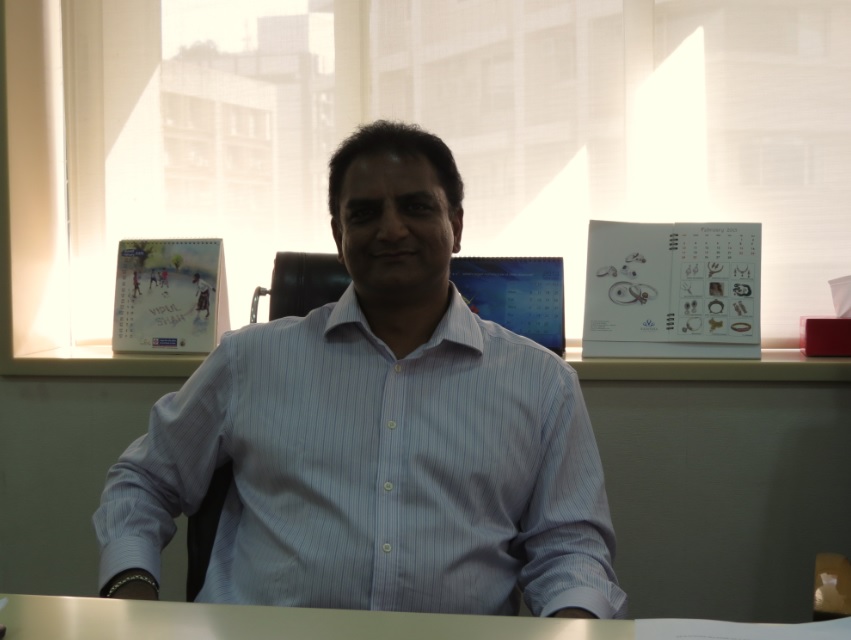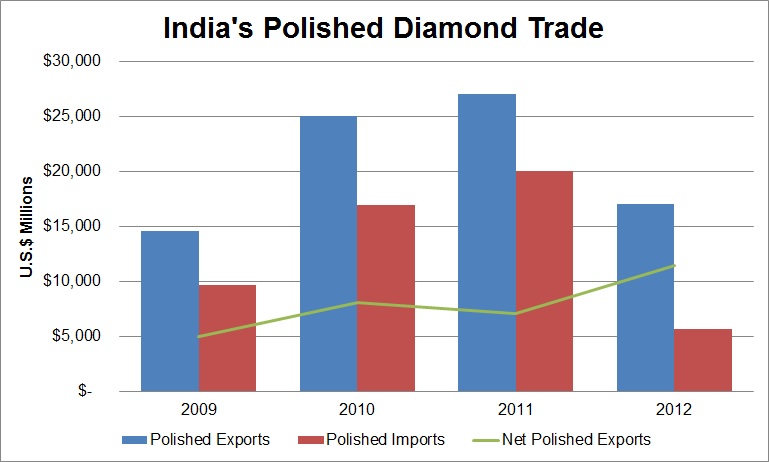|
|
Balancing Act - A Discussion with Vipul Shah
Editorial
Mar 8, 2013 6:00 AM
By Avi Krawitz
|
|
|
RAPAPORT... India’s Gem and Jewellery Export Promotion Council (GJEPC) tends to set an ambitious agenda for itself. With around 5,300 members across India, the industry body is tasked with lobbying government, trade and consumers to ensure growth for the gems and jewelry sector.
The task used to be easier. Faced with a widening current account deficit in a challenging global and domestic economy, the government has been forced to introduce measures that have not always been so friendly to the diamond and jewelry sectors or kind to foreign companies hoping to operate in that space. Higher imports on gold, silver and diamonds have aimed to curb imports and local consumption as a means to reduce the deficit.

That tends to put the council in an awkward position as members balance their willingness to contribute as proud Indians and their desire to grow the industry.
Vipul Shah, the recently elected GJEPC chairman, is all too aware of that dichotomy. In an exclusive interview with Rapaport News conducted on the eve of the February 28 budget announcement, Shah noted that the council’s lobby is ongoing.
The eagerly watched budget turned out to be bittersweet for the trade. While relatively well received by the country – Moody’s called it positive and optimistic, but challenging to achieve – very few of the council’s recommendations were included (see editorial, “India’s Gem & Jewelry Lobby,” published on February 8, 2013).
Biggest Challenge
Finance Minister Palaniappan Chidambaram avoided the additional gold import duty hikes that many expected. He already raised the duty from 4 percent to 6 percent in January.
However, he also did not adopt most of the proactive recommendations that the council requested to help grow the industry. Most important among these were implementing a more investor-friendly tax regime for rough mining companies to create a local rough trading hub, so that India’s enormous manufacturing sector can buy rough directly from the source in its own backyard.
Shah, who is also managing director of Asian Star, a diamond and jewelry manufacturing company, listed the local industry’s desire to establish a rough trading hub in Mumbai as a priority for the council in fiscal 2013-14.
“Right now, our biggest challenge is the sourcing of rough diamonds,” he said. “Currently, the goods are coming to us via Belgium, Dubai or Israel so we could cut down on significant transaction costs if the rough was sold directly here.”
The council has recommended the establishment of special notified zones for the import and trading of rough diamonds. These would enable mining companies to set up office in the zone and pay taxes only on the goods they sell, rather than on the full imported consignment that may include goods that remain unsold.
These things take time – especially in India. In a post-budget statement, Shah lauded the government for accepting a task group report to delve into the matter. He stressed that talks are ongoing to further its goals and the council “is eagerly waiting for the reform announcement by the foreign trade policy, which may be supportive of the gems and jewelry sector.”
Polished Window
Equally pressing, and included in the reform proposals, is maintaining some equilibrium in India’s polished diamond trade. Here too, the government failed to accept the council’s recommendations to allow a duty-free window on imports amounting to 15 percent of the previous year’s polished exports. The 2 percent duty introduced in January 2012 significantly reduced India’s polished imports, which Shah insists enabled the industry to make a positive contribution to the country’s economy.
“As it is the government is struggling with the current account deficit, so as a responsible council we came forward and asked them to impose the duty on polished diamonds,” he explained.
In hindsight, he added, the numbers speak for themselves. India’s polished imports ballooned to $20 billion in calendar 2011, closing in on the value of its polished exports. The duty, and a weak market, led polished imports to decline 72 percent to $5.63 billion in 2012, while polished exports fell 37 percent to $17.03 billion. India’s net polished exports – exports less imports indicating the net amount of polished goods leaving the country – grew 62 percent to a healthier $11.4 billion (see graph below).

Again, the council’s lobby is a work in progress and Shah explains that the 15 percent leeway will help companies avoid being taxed on goods sent out on consignment that are reimported unsold. Similarly, in the gold space, Shah stresses that the council walks a fine line between understanding the government’s current account constraints and the jewelry industry’s needs. Instead of further taxes, the council has recommended curbing demand for gold coins and medallions, which Shah estimates account for about 35 percent of the country’s gold imports. Stopping those imports would not affect the jewelry sector, he notes.
Focus on Growth
Despite the constraints, Shah, who was elected GJEPC chairman in October 2012, is optimistic about the market with the current final quarter of the fiscal year that ends on March 31, being the strongest so far. “We are seeing good orders both in SEEPZ –specialized economic zone for jewelry and also for loose stones,” he reported. “Overall, it looks more promising and we expect about 15 percent growth in gems and jewelry exports in the coming fiscal year.”
While such growth is expected to be spurred by the U.S., Far East and Middle East markets, the council is naturally also focused on capitalizing on India’s continued growth in diamond and jewelry consumption. Shah insists that India’s best years are not behind it and explains that the growth opportunity lies in the tier-2 cities.
“The Indian consumer has become more empowered and demanding and is increasingly quality and standard conscious,” he said. “There is an appetite for much more luxury and branded products than ever before.”
The council has engaged in an effort to directly target consumers with the launch of a retail (business-to-consumer) jewelry exhibition in New Delhi in April, adding to its more traditional business-to-business events. Based on its success, the idea may spread to other parts of the country. The council is also taking its India International Jewelry Week (IIJW - pictured below), which was launched in Mumbai three years ago, to international markets, starting with Dubai later this year.

Also on the international front, the council is intent on enhancing its buyer-seller meet events with groups from China, Russia, Australia, the U.S. among others and showcasing India at the major trade fairs such as in Hong Kong, Las Vegas, and Vicenza.
The council’s bigger test in the consumer space may be in its promotional activities as Shah explains that a generic marketing campaign is in the works. “With the absence of consistent promotion activity by any organization, GJEPC plans to take the initiative to promote diamonds in the consumer space, to boost demand for diamonds and diamond jewelry in India,” he stressed. “The timeline and modalities are being worked out and we expect to commence this activity very soon.”
Responsible to Whom?
Time will tell if the council can succeed in generic marketing where other efforts have failed. Many in the Indian diamond and jewelry market admit they could do with a boost and see the council as a key enabler for the local trade operating in an increasingly regulated environment.
“It’s a concern because while [these restrictions] don’t affect the export business, they are impacting the domestic market,” Shah said. “We are talking to government about it but they have their own issues being the current account.”
It’s an ongoing and necessary discussion. With its own budget and ambitious program in place to enhance the local industry, Shah and the GJEPC remain frustrated that the government could have made its task that much easier in the coming fiscal year. Meanwhile, since the treasury’s budget once again failed to deliver for the diamond and jewelry sector, the council is forced to continue to balance their responsibility to state and industry.
The writer can be contacted at avi@diamonds.net.
Follow Avi on Twitter: @AviKrawitz
This article is an excerpt from a market report that is sent to Rapaport members on a weekly basis. To subscribe, go to www.rapnet.com or contact your local Rapaport office.
Copyright © 2013 by Martin Rapaport. All rights reserved. Rapaport USA Inc., Suite 100 133 E. Warm Springs Rd., Las Vegas, Nevada, USA. +1.702.893.9400.
Disclaimer: This Editorial is provided solely for your personal reading pleasure. Nothing published by The Rapaport Group of Companies and contained in this report should be deemed to be considered personalized industry or market advice. Any investment or purchase decisions should only be made after obtaining expert advice. All opinions and estimates contained in this report constitute Rapaport`s considered judgment as of the date of this report, are subject to change without notice and are provided in good faith but without legal responsibility. Thank you for respecting our intellectual property rights.
|
|
|
|
|
|
|
|
|
|
Tags:
Asian Star, Avi Krawitz, diamonds, Gem & Jewellery Export Promotion Council, GJEPC, India, jewellery, Jewelry, Rapaport, Vipul Shah
|
|
|
|
|
|
|
|
|
|
|

|
|